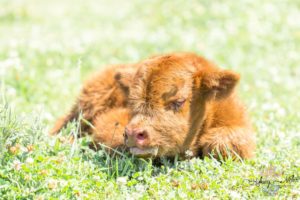The shaggy haired, long horned Highland is closely associated with the beauty, mystery, and romance of the Scottish Highlands. Underneath this dramatic appearance lies a useful and productive cattle breed. The Highland descends from the native cattle of Scotland and is named for the Highland region. The breed was shaped primarily by natural selection, and as a result it is best known for its survival qualities hardiness, maternal abilities, reproductive efficiency, and longevity. Highland cattle thrive on rough forage and in cold, wet climates. Like the other Scottish beef breeds, the Galloway, Belted Galloway, and Angus, the Highland is celebrated for the excellence of its beef.
 The early history of the Highland is not well recorded, though the breed was improved and standardized during the 1800s. Improvement was made through selection alone; the Highland never had any introductions from other breeds. Cattle were raised in the Highlands and on the islands nearby. They were sometimes called kyloe cattle, for they swam across the straits (or kyloes) on their way to market on the mainland. The breed became well known in Scotland and England, and a herdbook was established in 1884.
The early history of the Highland is not well recorded, though the breed was improved and standardized during the 1800s. Improvement was made through selection alone; the Highland never had any introductions from other breeds. Cattle were raised in the Highlands and on the islands nearby. They were sometimes called kyloe cattle, for they swam across the straits (or kyloes) on their way to market on the mainland. The breed became well known in Scotland and England, and a herdbook was established in 1884.
Highland cattle were first imported to North America in the 1880s, and importations have continued throughout the 1900s. The breed has always had a small but loyal following, especially in the northern part of the United States and in Canada. It is only recently, however, that Highlands are achieving their greatest popularity. One of the breed’s assets is its foraging ability. Highlands consume a wide variety of pest plants as well as grass and can be used to improve pastures. The breed is considered a “light grazer” in Europe, used to manage and diversify marginal lands without the negative impact seen with heavier breeds.
Highlands are medium in size, with cows weighing 900–1,300 pounds and bulls 1,500–2,000 pounds. Cattle have long, shaggy coats. Light red is the most common color, but many other solid colors are also seen, including black, brindle, cream, dun, red and white. The horns of the Highland cows sweep out and up, while those of the bulls are horizontal with upturned tips.
 The Highland is increasing in numbers in North America and globally, with populations found in Australia, Britain, Germany, and elsewhere in Europe. Despite its strength of numbers, however, the Highland faces a threat to its genetic integrity. The European Union (E.U.), an economic organization of most European countries and Great Britain, has issued directives requiring that all livestock herd books in member countries become “compatible.” This means that animals recognized by a herdbook in one country must be accorded recognition by herdbooks in other member countries. Many European herdbooks allow upgrading and will register animals with as little as three-fourths pure breeding as purebreds. If E.U. directives force the British studbook to become open to crossbred Highland cattle from Europe, then the consistency and purity of the breed will be reduced. The United States and Canada, whose closed herdbooks remain outside the jurisdiction of the E.U., may soon be the best reservoir of purebred Highland genetics in the world. It is for this reason that the breed, though relatively numerous, has remained a conservation priority, with emphasis placed on the estimated 10,000 Highlands in North America.
The Highland is increasing in numbers in North America and globally, with populations found in Australia, Britain, Germany, and elsewhere in Europe. Despite its strength of numbers, however, the Highland faces a threat to its genetic integrity. The European Union (E.U.), an economic organization of most European countries and Great Britain, has issued directives requiring that all livestock herd books in member countries become “compatible.” This means that animals recognized by a herdbook in one country must be accorded recognition by herdbooks in other member countries. Many European herdbooks allow upgrading and will register animals with as little as three-fourths pure breeding as purebreds. If E.U. directives force the British studbook to become open to crossbred Highland cattle from Europe, then the consistency and purity of the breed will be reduced. The United States and Canada, whose closed herdbooks remain outside the jurisdiction of the E.U., may soon be the best reservoir of purebred Highland genetics in the world. It is for this reason that the breed, though relatively numerous, has remained a conservation priority, with emphasis placed on the estimated 10,000 Highlands in North America.
